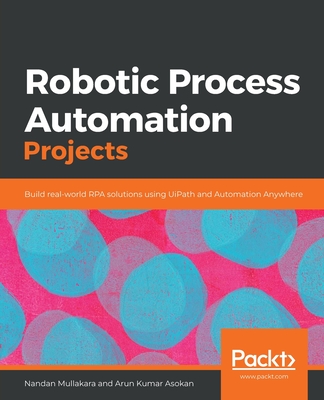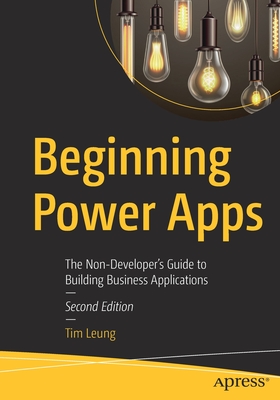Democratizing Artificial Intelligence with UiPath: Expand automation in your organization to achieve operational efficiency and high performance (Paperback)
暫譯: 用 UiPath 實現人工智慧的民主化:擴展組織中的自動化以達成運營效率和高效能 (平裝本)
Ip, Fanny, Crowley, Jeremiah
- 出版商: Packt Publishing
- 出版日期: 2022-04-29
- 售價: $2,010
- 貴賓價: 9.5 折 $1,910
- 語言: 英文
- 頁數: 376
- 裝訂: Quality Paper - also called trade paper
- ISBN: 1801817650
- ISBN-13: 9781801817653
-
相關分類:
AI Coding
立即出貨 (庫存=1)
買這商品的人也買了...
-
 Configuring SAP ERP Sales and Distribution (Hardcover)
Configuring SAP ERP Sales and Distribution (Hardcover)$2,740$2,603 -
 $469從機器學習到深度學習:基於scikit-learn與TensorFlow的高效開發實戰
$469從機器學習到深度學習:基於scikit-learn與TensorFlow的高效開發實戰 -
 精通 OpenCV 3 (Mastering OpenCV 3, 2/e)
精通 OpenCV 3 (Mastering OpenCV 3, 2/e)$500$390 -
 數位訊號處理-Python 程式實作, 2/e (附實作光碟)
數位訊號處理-Python 程式實作, 2/e (附實作光碟)$500$450 -
 Learn Microsoft PowerApps
Learn Microsoft PowerApps$2,130$2,024 -
 Robotic Process Automation Projects: Build real-world RPA solutions using UiPath and Automation Anywhere (Paperback)
Robotic Process Automation Projects: Build real-world RPA solutions using UiPath and Automation Anywhere (Paperback)$1,740$1,653 -
 $254RPA 機器人流程自動化快速入門 基於 Blue Prism (Robotic Process Automation with Blue Prism Quick Start Guide: Create software robots and automate business processes)
$254RPA 機器人流程自動化快速入門 基於 Blue Prism (Robotic Process Automation with Blue Prism Quick Start Guide: Create software robots and automate business processes) -
 $403RPA 學習指南:使用 UiPath 構建軟件機器人與自動化業務流程 (Learning Robotic Process Automation)
$403RPA 學習指南:使用 UiPath 構建軟件機器人與自動化業務流程 (Learning Robotic Process Automation) -
 Robotic Process Automation with Automation Anywhere: Techniques to fuel business productivity and intelligent automation using RPA
Robotic Process Automation with Automation Anywhere: Techniques to fuel business productivity and intelligent automation using RPA$2,060$1,957 -
 $1,528Beginning Power Apps: The Non-Developer's Guide to Building Business Applications (Paperback)
$1,528Beginning Power Apps: The Non-Developer's Guide to Building Business Applications (Paperback) -
 Robotic Process Automation Using Uipath Studiox: A Citizen Developer's Guide to Hyperautomation (Paperback)
Robotic Process Automation Using Uipath Studiox: A Citizen Developer's Guide to Hyperautomation (Paperback)$1,980$1,881 -
 $505實戰低代碼
$505實戰低代碼 -
 Empowering Organizations with Power Virtual Agents: A practical guide to building intelligent chatbots with Microsoft Power Platform (Paperback)
Empowering Organizations with Power Virtual Agents: A practical guide to building intelligent chatbots with Microsoft Power Platform (Paperback)$1,500$1,425 -
 $673UiPath RPA 開發:入門、實戰與進階
$673UiPath RPA 開發:入門、實戰與進階 -
 Exam Ref AI-900 Microsoft Azure AI Fundamentals (Paperback)
Exam Ref AI-900 Microsoft Azure AI Fundamentals (Paperback)$1,560$1,482 -
 從 Power BI 到 Power Platform 低代碼應用開發實戰
從 Power BI 到 Power Platform 低代碼應用開發實戰$539$512 -
 Visual Studio Code 實用指南:官方文件沒有詳述的 Extension 觀念、命令組合技與鍵位客製化技巧(iT邦幫忙鐵人賽系列書)
Visual Studio Code 實用指南:官方文件沒有詳述的 Extension 觀念、命令組合技與鍵位客製化技巧(iT邦幫忙鐵人賽系列書)$600$468 -
 Microsoft 365 + Power Platform 企業數字化轉型全攻略
Microsoft 365 + Power Platform 企業數字化轉型全攻略$654$621 -
 UiPath Associate Certification Guide: The go-to guide to passing the Associate certification exam with the help of mock tests and quizzes (Paperback)
UiPath Associate Certification Guide: The go-to guide to passing the Associate certification exam with the help of mock tests and quizzes (Paperback)$1,800$1,710 -
 UiPath Administration and Support Guide: Learn industry-standard practices for UiPath program support and administration activities (Paperback)
UiPath Administration and Support Guide: Learn industry-standard practices for UiPath program support and administration activities (Paperback)$1,400$1,330 -
 ChatGPT 開發手冊 Turbo × Vision 進化版 — 用 OpenAI Chat/Assistants API‧Function calling 設計 GPTs action‧LINE/Discord bot‧股市分析/自動助理
ChatGPT 開發手冊 Turbo × Vision 進化版 — 用 OpenAI Chat/Assistants API‧Function calling 設計 GPTs action‧LINE/Discord bot‧股市分析/自動助理$820$648 -
 Intelligent Automation with Blue Prism: Design intelligent automation solutions using best practices with RPA and machine learning
Intelligent Automation with Blue Prism: Design intelligent automation solutions using best practices with RPA and machine learning$1,530$1,454 -
 跟 NVIDIA 學深度學習!從基本神經網路到 ......、GPT、BERT...,紮穩機器視覺與大型語言模型 (LLM) 的建模基礎
跟 NVIDIA 學深度學習!從基本神經網路到 ......、GPT、BERT...,紮穩機器視覺與大型語言模型 (LLM) 的建模基礎$880$695 -
 Learning Microsoft Power Apps: Building Business Applications with Low-Code Technology
Learning Microsoft Power Apps: Building Business Applications with Low-Code Technology$1,995$1,890 -
 最強 AI 組合技!NotebookLM / Gemini / Nano Banana / Veo 3 【影音生成進化版】
最強 AI 組合技!NotebookLM / Gemini / Nano Banana / Veo 3 【影音生成進化版】$499$394
商品描述
Build an end-to-end business solution in the cognitive automation lifecycle and explore UiPath Document Understanding, UiPath AI Center, and Druid
Key Features
- Explore out-of-the-box (OOTB) AI Models in UiPath
- Learn how to deploy, manage, and continuously improve machine learning models using UiPath AI Center
- Deploy UiPath-integrated chatbots and master UiPath Document Understanding
Book Description
Artificial intelligence (AI) enables enterprises to optimize business processes that are probabilistic, highly variable, and require cognitive abilities with unstructured data. Many believe there is a steep learning curve with AI, however, the goal of our book is to lower the barrier to using AI. This practical guide to AI with UiPath will help RPA developers and tech-savvy business users learn how to incorporate cognitive abilities into business process optimization. With the hands-on approach of this book, you'll quickly be on your way to implementing cognitive automation to solve everyday business problems.
Complete with step-by-step explanations of essential concepts, practical examples, and self-assessment questions, this book will help you understand the power of AI and give you an overview of the relevant out-of-the-box models. You'll learn about cognitive AI in the context of RPA, the basics of machine learning, and how to apply cognitive automation within the development lifecycle. You'll then put your skills to test by building three use cases with UiPath Document Understanding, UiPath AI Center, and Druid.
By the end of this AI book, you'll be able to build UiPath automations with the cognitive capabilities of intelligent document processing, machine learning, and chatbots, while understanding the development lifecycle.
What you will learn
- Discover how to bridge the gap between RPA and cognitive automation
- Understand how to configure, deploy, and maintain ML models in UiPath
- Explore OOTB models to manage documents, chats, emails, and more
- Prepare test data and test cases for user acceptance testing (UAT)
- Build a UiPath automation to act upon Druid responses
- Find out how to connect custom models to RPA
Who this book is for
AI Engineers and RPA developers who want to upskill and deploy out-of-the-box models using UiPath's AI capabilities will find this guide useful. A basic understanding of robotic process automation and machine learning will be beneficial but not mandatory to get started with this UiPath book.
商品描述(中文翻譯)
建立一個端到端的商業解決方案,涵蓋認知自動化生命周期,並探索 UiPath Document Understanding、UiPath AI Center 和 Druid
主要特點
- 探索 UiPath 中的即用型 (OOTB) AI 模型
- 學習如何使用 UiPath AI Center 部署、管理和持續改進機器學習模型
- 部署與 UiPath 整合的聊天機器人,並精通 UiPath Document Understanding
書籍描述
人工智慧 (AI) 使企業能夠優化那些具有概率性、高變異性且需要認知能力的商業流程,特別是處理非結構化數據。許多人認為 AI 學習曲線陡峭,然而,我們這本書的目標是降低使用 AI 的門檻。這本關於 UiPath 的實用指南將幫助 RPA 開發人員和技術精通的商業用戶學習如何將認知能力融入商業流程優化中。透過本書的實作方式,您將迅速開始實施認知自動化,以解決日常商業問題。
本書包含對基本概念的逐步解釋、實用範例和自我評估問題,將幫助您理解 AI 的力量,並提供相關即用型模型的概述。您將學習 RPA 中的認知 AI、機器學習的基本知識,以及如何在開發生命周期中應用認知自動化。接著,您將通過使用 UiPath Document Understanding、UiPath AI Center 和 Druid 建立三個使用案例來檢驗您的技能。
在這本 AI 書籍結束時,您將能夠建立具備智能文檔處理、機器學習和聊天機器人認知能力的 UiPath 自動化,同時理解開發生命周期。
您將學到的內容
- 探索如何彌合 RPA 與認知自動化之間的差距
- 理解如何在 UiPath 中配置、部署和維護機器學習模型
- 探索即用型模型以管理文檔、聊天、電子郵件等
- 準備用戶驗收測試 (UAT) 的測試數據和測試案例
- 建立一個 UiPath 自動化以根據 Druid 的回應行動
- 瞭解如何將自定義模型連接到 RPA
本書適合對象
希望提升技能並使用 UiPath 的 AI 功能部署即用型模型的 AI 工程師和 RPA 開發人員將會發現這本指南非常有用。對機器人流程自動化和機器學習的基本理解將有助於開始閱讀這本 UiPath 書籍,但並非必須。
作者簡介
Fanny Ip is a thought leader in Automation, Business Transformation, and Innovation. Currently, Fanny is the VP of the Automation Consulting Innovation Office at UiPath and leads a team of experienced management consultants to develop field-tested solutions for customers - from start-up, expand, to scale.
Before joining UiPath, Fanny co-led McKinsey's Automation practice in North America and developed automation strategies for CxOs to deliver top-line revenue growth and achieve bottom-line impact. Before automation, Fanny has also led many business transformation projects at PwC Advisory and Deloitte Consulting. Fanny earned a BA in Economics from the University of Chicago and an MBA from the Anderson School of Management at UCLA. Originally from Hong Kong, Fanny resides in Los Angeles with her family.
Jeremiah is a multi-disciplined developer with a wide technical and operational lens. His initial passion for software development and implementation led him to automation and process efficiency. He enjoys working on and solving problems irrespective of size and technology. Jeremiah received his BA in Computer Science from New York University. His work history includes the likes of EY and McKinsey & Company, where he played roles within their Automation and Service Operations practices. He is currently a Director Manager within UiPath’s Automation Consulting Innovation Office, assisting organizations drive adoption and scale of automation by managing digital transformation initiatives and developing hyper-automation frameworks and methodologies.
作者簡介(中文翻譯)
Fanny Ip 是自動化、商業轉型和創新的思想領袖。目前,Fanny 擔任 UiPath 自動化諮詢創新辦公室的副總裁,領導一支經驗豐富的管理顧問團隊,為客戶開發經過實地測試的解決方案,涵蓋從創業、擴展到規模化的各個階段。
在加入 UiPath 之前,Fanny 共同領導了麥肯錫在北美的自動化業務,為 CxO 制定自動化策略,以實現營收增長並達成底線影響。在進入自動化領域之前,Fanny 也曾在 PwC 諮詢和德勤顧問公司領導多個商業轉型項目。Fanny 擁有芝加哥大學的經濟學學士學位和加州大學洛杉磯分校安德森管理學院的 MBA 學位。Fanny 來自香港,目前與家人居住在洛杉磯。
Jeremiah 是一位多學科的開發者,擁有廣泛的技術和運營視野。他最初對軟體開發和實施的熱情使他進入了自動化和流程效率的領域。他喜歡處理和解決各種大小和技術的問題。Jeremiah 擁有紐約大學的計算機科學學士學位。他的工作經歷包括安永(EY)和麥肯錫公司,在這些公司中,他在自動化和服務運營實踐中擔任過多個角色。目前,他是 UiPath 自動化諮詢創新辦公室的董事經理,協助組織推動自動化的採用和擴展,通過管理數位轉型計劃和開發超自動化框架及方法論。
目錄大綱
1. Understanding Essential Artificial Intelligence Basics for RPA Developers
2. Bridging the Gap between RPA and Cognitive Automation
3. Understanding the UiPath Platform in the Cognitive Automation Life Cycle
4. Identifying Cognitive Opportunities
5. Designing Automation with End User Considerations
6. Understanding Your Tools
7. Testing and Refining Development Efforts
8. Use Case 2 - Email Classification with AI Center
9. Use Case 3 - Chatbots with Druid
10. AI Center Advanced Topics
目錄大綱(中文翻譯)
1. Understanding Essential Artificial Intelligence Basics for RPA Developers
2. Bridging the Gap between RPA and Cognitive Automation
3. Understanding the UiPath Platform in the Cognitive Automation Life Cycle
4. Identifying Cognitive Opportunities
5. Designing Automation with End User Considerations
6. Understanding Your Tools
7. Testing and Refining Development Efforts
8. Use Case 2 - Email Classification with AI Center
9. Use Case 3 - Chatbots with Druid
10. AI Center Advanced Topics




























